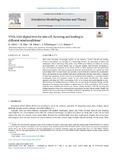Mostrar el registro sencillo del ítem
VTOL UAV digital twin for take-off, hovering and landing in different wind conditions
| dc.creator | Aláez Gómez, Daniel | es_ES |
| dc.creator | Olaz Moratinos, Xabier | es_ES |
| dc.creator | Prieto Míguez, Manuel | es_ES |
| dc.creator | Villadangos Alonso, Jesús | es_ES |
| dc.creator | Astrain Escola, José Javier | es_ES |
| dc.date.accessioned | 2023-02-15T08:09:57Z | |
| dc.date.available | 2023-02-15T08:09:57Z | |
| dc.date.issued | 2023 | |
| dc.identifier.citation | Aláez, D., Olaz, X., Prieto, M., Villadangos, J., & Astrain, J. J. (2023). VTOL UAV digital twin for take-off, hovering and landing in different wind conditions. Simulation Modelling Practice and Theory, 123, 102703. https://doi.org/10.1016/j.simpat.2022.102703 | en |
| dc.identifier.issn | 1569-190X | |
| dc.identifier.uri | https://hdl.handle.net/2454/44701 | |
| dc.description.abstract | With UAVs becoming increasingly popular in the industry, vertical take-off and landing (VTOL) convertiplanes are emerging as a compromise between the advantages of planes and multicopters. Due to their large wing surface area, VTOL convertiplanes are subject to a strong wind dependence on critical phases such as take-off, landing, and hovering. Developing a new and improved unmanned aerial vehicle (UAV) is often expensive and associated with failures and accidents. This paper proposes the dynamic characterization of a commercial VTOL convertiplane UAV in copter mode and provides a novel method to estimate the aerodynamic forces and moments for any possible wind speed and direction. Starting from Euler’s equations of rigid body dynamics, we have derived the mathematical formulation to precisely consider aerodynamic forces and moments caused by any wind speed and direction. This unique approach will allow for VTOL convertiplane UAVs to be trained and tested digitally in takeoff, hovering, and landing maneuvers without the cost and hassle of physical testing, and the dependence on existing wind conditions. A digital twin of a VTOL convertiplane UAV in copter mode has been modeled and tested in the Gazebo robotics simulator. Take-off, hovering and landing maneuvers have been compared with and without the wind physics model. Finally, the simulator has been tested against real flight conditions (reproducing the mean wind speed and direction only), showing a natural and realistic behavior. | en |
| dc.description.sponsorship | This work has been supported in part by the Ministerio de Ciencia e Innovación (Spain) under the research grant RTI2018-095499-B-C31 IoTrain; in part by Agencia Estatal de Investigación (AEI) and European Union NextGenerationEU/PRTR PLEC2021-007997: Holistic power lines predictive maintenance system; and in part by the Government of Navarre (Departamento de Desarrollo Económico) under the research grants 0011-1411-2021-000021 EMERAL: Emergency UAVs for long range operations, 0011-1365-2020-000078 DIVA, and 0011-1411-2021-000025 MOSIC: Plataforma logística de largo alcance, eléctrica y conectada. | en |
| dc.format.mimetype | application/pdf | en |
| dc.format.mimetype | application/zip | en |
| dc.language.iso | eng | en |
| dc.publisher | Elsevier | en |
| dc.relation.ispartof | Simulation Modelling Practice and Theory 123 (2023) 102703 | en |
| dc.rights | © 2022 The Author(s). This is an open access article under the CC BY-NC-ND license | en |
| dc.rights.uri | http://creativecommons.org/licenses/by-nc-nd/4.0/ | |
| dc.subject | VTOL | en |
| dc.subject | UAV | en |
| dc.subject | Digital twin | en |
| dc.subject | Aerodynamic coefficients | en |
| dc.subject | Gazebo | en |
| dc.subject | Wind model | en |
| dc.title | VTOL UAV digital twin for take-off, hovering and landing in different wind conditions | en |
| dc.type | Artículo / Artikulua | es |
| dc.type | info:eu-repo/semantics/article | en |
| dc.date.updated | 2023-02-15T07:46:25Z | |
| dc.contributor.department | Estadística, Informática y Matemáticas | es_ES |
| dc.contributor.department | Estatistika, Informatika eta Matematika | eu |
| dc.contributor.department | Institute of Smart Cities - ISC | en |
| dc.rights.accessRights | Acceso abierto / Sarbide irekia | es |
| dc.rights.accessRights | info:eu-repo/semantics/openAccess | en |
| dc.identifier.doi | 10.1016/j.simpat.2022.102703 | |
| dc.relation.projectID | info:eu-repo/grantAgreement/AEI/Plan Estatal de Investigación Científica y Técnica y de Innovación 2017-2020/RTI2018-095499-B-C31/ES/ | en |
| dc.relation.projectID | info:eu-repo/grantAgreement/AEI/Plan Estatal de Investigación Científica y Técnica y de Innovación 2017-2020/PLEC2021-007997 | en |
| dc.relation.publisherversion | https://doi.org/10.1016/j.simpat.2022.102703 | |
| dc.type.version | Versión publicada / Argitaratu den bertsioa | es |
| dc.type.version | info:eu-repo/semantics/publishedVersion | en |
| dc.contributor.funder | Gobierno de Navarra / Nafarroako Gobernua | es |



